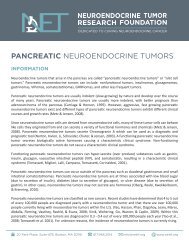PANCREATIC NEUROENDOCRINE TUMORS
You also want an ePaper? Increase the reach of your titles
YUMPU automatically turns print PDFs into web optimized ePapers that Google loves.
• Rockall, A.G., Reznek, R.H. (2007). Imaging of neuroendocrine tumours (CT/MR/US). Best Pract Res Clin<br />
Endocrinol Metab. 21(1):43-68. Retrieved from: http://www.ncbi.nlm.nih.gov/pubmed/17382265<br />
• Reidy, D. L., Tang, L. H., Saltz, L. B. (2009). Treatment of advanced disease in patients with well-differentiated<br />
neuroendocrine tumors. Nature Clinical Practice, Oncology, 6(3), 143-152. Retrieved from: http://www.ncbi.<br />
nlm.nih.gov/pubmed/19190591.<br />
• Reubi, J., Kvolz, L., Waser, B., Nagorney, D., Heitz, P., Chaboneau, J., Reading, C., Moertel, C. (1990). Detection of<br />
somatostatin receptors in surgical percutaneous needle biopsy samples of carcinoids and islet cell carcinomas.<br />
Cancer Research, 50(18), 5969-5977. Retrieved from: http://www.ncbi.nlm.nih.gov/pubmed/2168286.<br />
• Sundin, A., Garske, U., Orlefors, H. (2007). Nuclear imaging of neuroendocrine tumours. Best Practice &<br />
Research, Clinical Endocrinology & Metabolism, 21(1), 69-85. Retrieved from: http://www.ncbi.nlm.nih.gov/<br />
pubmed/17382266.<br />
• Tomasseti, P., Migliori, M., Lalli, S., Campana, D., Tomassetti, V., Corinaldesi, R. (2001). Epidemiology, clinical<br />
features and diagnosis of gastroenteropancreatic endocrine tumours. Annals of Oncology, 12(2), S95-S99.<br />
Retrieved from: http://www.ncbi.nlm.nih.gov/pubmed/11762360.<br />
• Vinik, A., Strodel, W., Eckhauser, F., Moattari, A., Lloyd, R. (1987). Somatostatinomas, PPomas, neurotensinomas.<br />
Seminars in Oncology, 14(3), 263-281. Retrieved from: http://www.ncbi.nlm.nih.gov/pubmed/2820062.<br />
• Vinik, A., Woltering, E., Warner, R., Caplin, M., O’Dorisio, T., Wiseman, G., Coppola, D., Go, V. (2010). NANETS<br />
Consensus Guidelines for the Diagnosis of Neuroendocrine Tumor. Pancreas, 39(6), 713-734.<br />
TREATMENT<br />
Pancreatic Neuroendocrine Tumor Treatment<br />
Pancreatic neuroendocrine tumors can be very difficult to treat. Pancreatic neuroendocrine tumors can be benign<br />
to highly malignant, indolent (slow growing) to very aggressive in development, and range from asymptomatic to<br />
causing debilitating syndromes. As a result, a multi-disciplinary team consisting of specialist physicians in NETs<br />
(gastroenterologists, oncologists, and endocrinologists), surgeons, radiologists, nuclear medicine specialists,<br />
histopathlogists, and clinical nurse specialists is often recommended (Ramage, Ahmed, Ardill, Bax, Breen, Caplin,<br />
Corrie, Davar, Davies, Lewington, Meyer, Newell-Price, Poston, Reed, Rockall, Steward, Thakker, Toubanakis,<br />
Valle, Verbeke, Grossman, and UK and Ireland Neuroendocrine Tumor Society, 2012).<br />
Pancreatic Neuroendocrine Tumor treatment must be tailored to each patient’s tumor burden and symptoms.<br />
Treatments may be focused on inhibiting tumor growth or symptom relief. Often, this means that any given<br />
treatment plan may consist of a combination and/or series of several treatments. Be sure to discuss treatment<br />
options thoroughly with your physician(s). Ultimately, all treatment decisions should be made by the patient.<br />
Pancreatic Neuroendocrine Tumor Surgery<br />
The surgical treatment of pancreatic neuroendocrine tumors depends on the tumor type, location, extent of<br />
metastases, as well as other factors. For individuals who have metastases, surgery can often increase survival<br />
and provide palliative care depending on tumor size and location (Steinmuller, Kianmanesh, Falconi, Scarpa,<br />
Taal, Kwekkeboom, Lopes, Perren, Nikou, Yao, Dell Fave, O’Toole, & Frascati Consensus Conference participants,<br />
20 Park Plaza, Suite 478, Boston, MA 02116 617.948.2514 info@netrf.org www.netrf.org
















